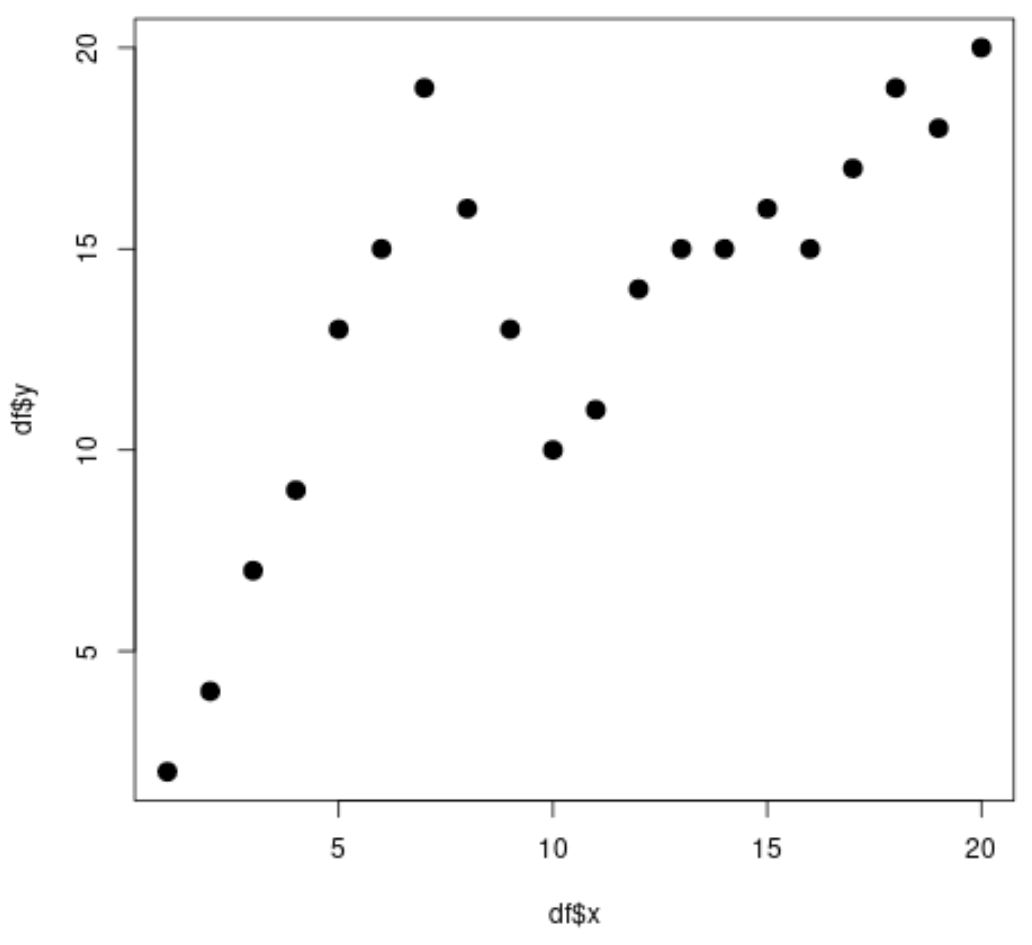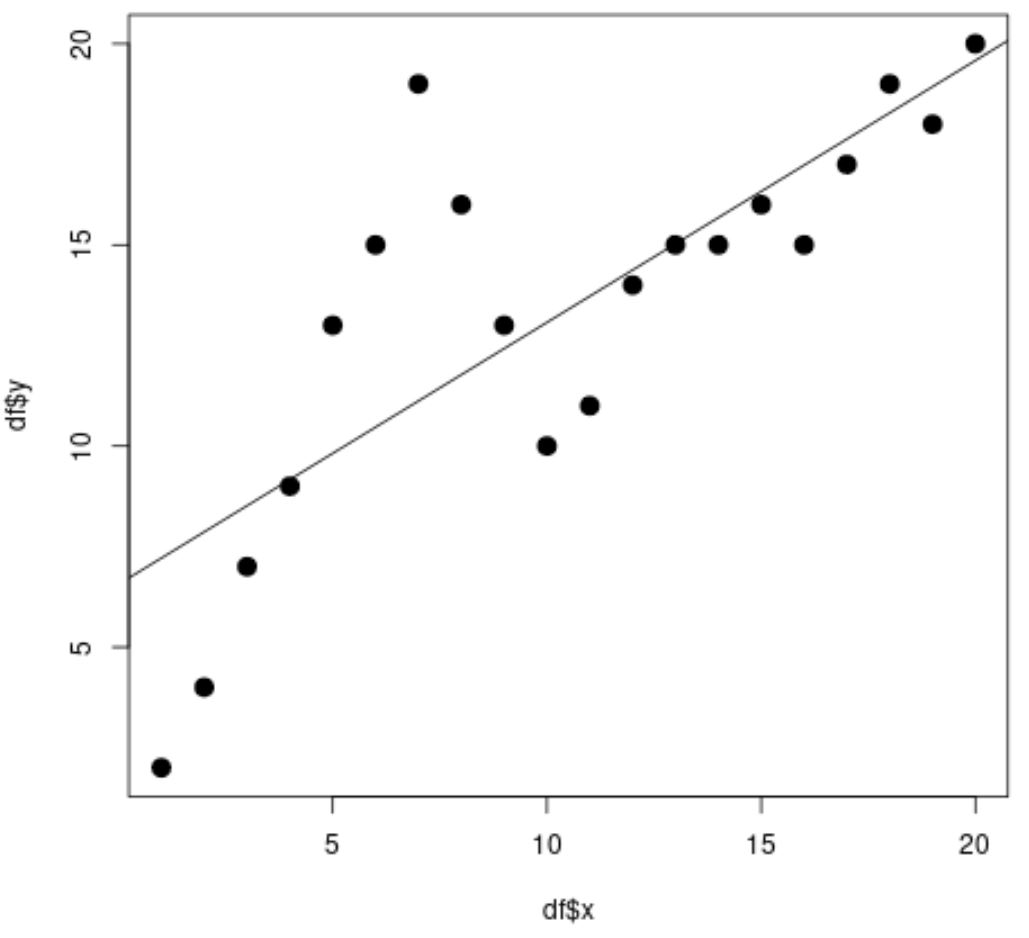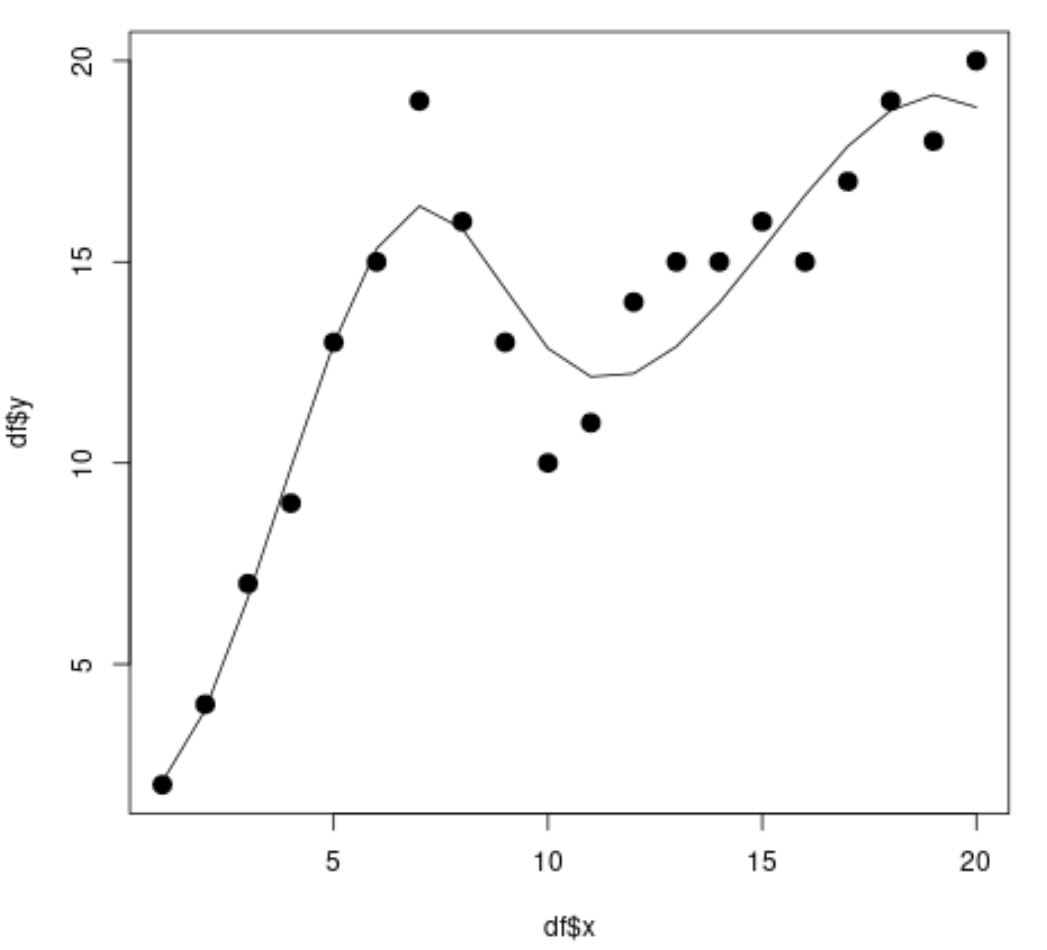Spline regression is a type of regression that is used when there are points or “knots” where the pattern in the data abruptly changes and linear regression and polynomial regression aren’t flexible enough to fit the data.
The following step-by-step example shows how to perform spline regression in R.
Step 1: Create the Data
First, let’s create a dataset in R with two variables and create a scatterplot to visualize the relationship between the variables:
#create data frame df frame(x=1:20, y=c(2, 4, 7, 9, 13, 15, 19, 16, 13, 10, 11, 14, 15, 15, 16, 15, 17, 19, 18, 20)) #view head of data frame head(df) x y 1 1 2 2 2 4 3 3 7 4 4 9 5 5 13 6 6 15 #create scatterplot plot(df$x, df$y, cex=1.5, pch=19)

Clearly the relationship between x and y is non-linear and there appear to be two points or “knots” where the pattern in the data abruptly changes at x = 7 and x = 10.
Step 2: Fit Simple Linear Regression Model
Next, let’s use the lm() function to fit a simple linear regression model to this dataset and plot the fitted regression line on the scatterplot:
#fit simple linear regression model linear_fit #view model summary summary(linear_fit) Call: lm(formula = df$y ~ df$x) Residuals: Min 1Q Median 3Q Max -5.2143 -1.6327 -0.3534 0.6117 7.8789 Coefficients: Estimate Std. Error t value Pr(>|t|) (Intercept) 6.5632 1.4643 4.482 0.000288 *** df$x 0.6511 0.1222 5.327 4.6e-05 *** --- Signif. codes: 0 '***' 0.001 '**' 0.01 '*' 0.05 '.' 0.1 ' ' 1 Residual standard error: 3.152 on 18 degrees of freedom Multiple R-squared: 0.6118, Adjusted R-squared: 0.5903 F-statistic: 28.37 on 1 and 18 DF, p-value: 4.603e-05 #create scatterplot plot(df$x, df$y, cex=1.5, pch=19) #add regression line to scatterplot abline(linear_fit)

From the scatterplot we can see that the simple linear regression line doesn’t fit the data well.
From the model output we can also see that the adjusted R-squared value is 0.5903.
We’ll compare this to the adjusted R-squared value of a spline model.
Step 3: Fit Spline Regression Model
Next, let’s use the bs() function from the splines package to fit a spline regression model with two knots and then plot the fitted model on the scatterplot:
library(splines) #fit spline regression model spline_fit 7, 10))) #view summary of spline regression model summary(spline_fit) Call: lm(formula = df$y ~ bs(df$x, knots = c(7, 10))) Residuals: Min 1Q Median 3Q Max -2.84883 -0.94928 0.08675 0.78069 2.61073 Coefficients: Estimate Std. Error t value Pr(>|t|) (Intercept) 2.073 1.451 1.429 0.175 bs(df$x, knots = c(7, 10))1 2.173 3.247 0.669 0.514 bs(df$x, knots = c(7, 10))2 19.737 2.205 8.949 3.63e-07 *** bs(df$x, knots = c(7, 10))3 3.256 2.861 1.138 0.274 bs(df$x, knots = c(7, 10))4 19.157 2.690 7.121 5.16e-06 *** bs(df$x, knots = c(7, 10))5 16.771 1.999 8.391 7.83e-07 *** --- Signif. codes: 0 '***' 0.001 '**' 0.01 '*' 0.05 '.' 0.1 ' ' 1 Residual standard error: 1.568 on 14 degrees of freedom Multiple R-squared: 0.9253, Adjusted R-squared: 0.8987 F-statistic: 34.7 on 5 and 14 DF, p-value: 2.081e-07 #calculate predictions using spline regression model x_lim 1], x_lim[2]) preds #create scatter plot with spline regression predictions plot(df$x, df$y, cex=1.5, pch=19) lines(x_grid, preds)

From the scatterplot we can see that the spline regression model is able to fit the data quite well.
From the model output we can also see that the adjusted R-squared value is 0.8987.
The adjusted R-squared value for this model is much higher than the simple linear regression model, which tells us that the spline regression model is able to fit the data much better.
Note that for this example we chose the knots to be located at x=7 and x=10.
In practice, you’ll have to pick the knot locations yourself based on where the patterns in the data appear to change and based on domain expertise.
Additional Resources
The following tutorials explain how to perform other common tasks in R:
How to Perform Multiple Linear Regression in R
How to Perform Exponential Regression in R
How to Perform Weighted Least Squares Regression in R